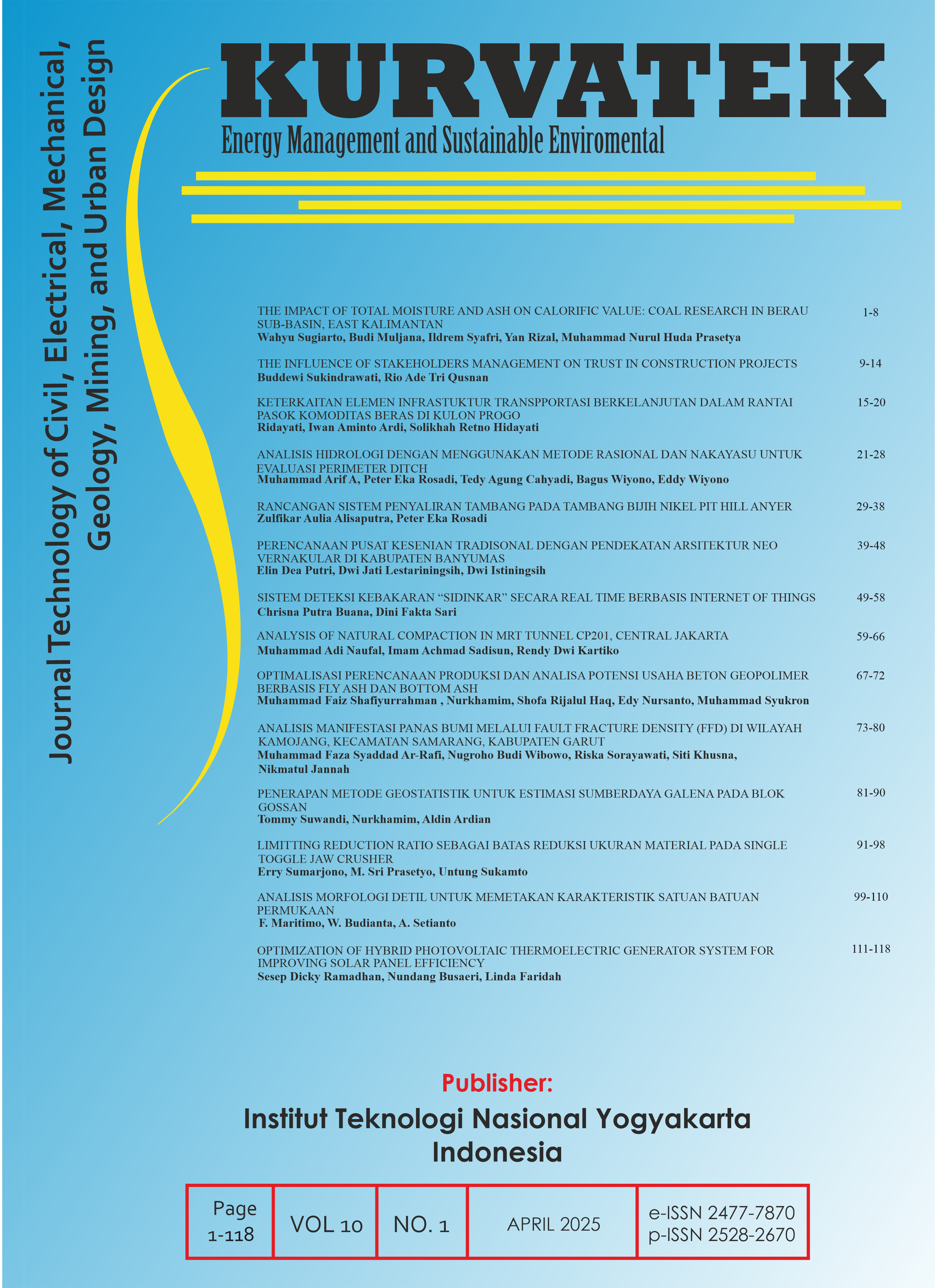LIMITTING REDUCTION RATIO SEBAGAI BATAS REDUKSI UKURAN MATERIAL PADA SINGLE TOGGLE JAW CRUSHER
DOI:
https://doi.org/10.33579/krvtk.v10i1.5723Kata Kunci:
Crushing, Jaw Crusher, Mineral Processing, Reduction Ratio, ReduksiAbstrak
Reduction Ratio (RR) dapat digunakan untuk memperkirakan ukuran produk yang dapat dihasilkan oleh suatu alat peremuk. Reduction ratio tersebut dapat dihitung dengan beberapa cara. Salah satu perhitungan yang dapat dilakukan adalah menghitung Limitting Reduction Ratio (LRR). Limitting Reduction Ratio merupakan perbandingan antara ukuran umpan terbesar dan ukuran produk terbesar. Penelitian ini bertujuan untuk menghitung Limitting Reduction Ratio pada operasi peremukan batu lempung sebanyak 30 sampel, yang dilakukan dalam skala laboratorium, dengan menggunakan alat peremuk tipe single toggle jaw crusher. Produk peremukan dipisahkan dengan hand sieving berukuran +4#, 10#, 20#, 40#, 60#,100#, 200#. Hasil penelitian menunjukkan bahwa, persentase produk peremukan yang dihasilkan masih terdapat pada ukuran sieve terbesar yaitu 4#, dengan jumlah rata-rata sebesar 52,33 %. Ukuran umpan terbesar berkisar antara 24 mm s/d 27 mm dan ukuran produk terbesar berkisar antara 4 mm s/d 6 mm. Hubungan antara total berat umpan dan total berat produk dapat dinyatakan dalam persamaan Y = 0,5229 X dan R2 = 0,9228, sedangkan hubungan ukuran umpan terbesar dengan ukuran produk terbesar dinyatakan dalam persamaan Y = 0,2044 X dan R2 = 0,9761. Perhitungan limitting reduction ratio berkisar antara 4,2 s/d 6,8, dengan nilai rata-rata sebesar 5,02.
Kata kunci: Crushing, Jaw Crusher, Mineral Processing, Reduction Ratio, Reduksi
Unduhan
Referensi
J. M. Currie, Unit Operation in Mineral Processing, Coulombia : CSM Press, 1973.
B. M. Olaleye, “Influence of Some Rock Strength Properties on Jaw Crusher Performance in Granite Quarry”, Mining Science and Technology, vol. 20, no. 2, pp. 204-208, Maret 2010. doi.org/10.1016/S1674-5264(09)60185-X
G. Asbjörnsson, “Crushing Plant Dinamics”, Thesis for The Degree of Doctor Philosophy in Product and Production Development, Department of Product and Production Development, Chalmers, University of Technology, Göthenborg, Sweden, 2015.
B. H. G. Brady dan E.T. Brown, Rock Mass Structure. In: Rock Mechanics, Springer, Dordrecht, 1985. doi: doi.org/10.1007/978-94-011-6501-3_3
P. N. Mwangi, O. M. Muvengei, and T. O. Mbuya, “Review of Discrete Element Modelling in Optimisation of Energy Consumption of a Single-Toggle Jaw Crusher”, Proceeding of the Sustainable Research and Innovation Conference, JKUAT Main Campus, 2-4 May 2018, Kenya, 2018.
M. Lindqvist dan C. M. Evertsson, “Liner Wear in Jaw Crusher”, Minerals Engineering, vol. 16, no. 1, pp. 1-12, Januari 2003. doi: doi.org/10.1016/S0892-6875(02)00179-6
J. Drzymala, Mineral Processing, Foundation of Theory and Practice of Minerallurgy, 1st English Edition, Wroclaw University of Technology, p. 122, 2007.
C. Okechukwu, et al., “Design and Operation Challenges of a Single Toggle Jaw Crusher : a Review”, Nigerian Journal of Technology (NIJOTEC), vol. 36, no. 3, pp. 814-821, Juli 2017. doi: dx.doi.org/10.4314/njt.v36i3.22
B. A. Wills and T. J. Napier-Munn, Will’s Mineral Processing Technology, an Introduction to the Practical Aspect of Ore Treatment and Recovery. Queensland : 7th Edition, Elsevier Science & Technology Books, pp. 119-120, 2006.
M. Evertssson, ”Cone Crusher Performance”, Ph.D Thesis, Department of Machine and Vehicle Design, Chalmers, University of Technology, Göthenborg, Sweden, 2000.
E. Lee, “Optimization of Compressive Crushing”, Ph.D Thesis, Department of Product and Production Development, Chalmers, University of Technology, Göthenborg, Sweden, 2012.
S. R. Krogh, Crushing Characteristic. Powder Technology: 27. @Elsevier Seqoula S.A. Lausanne-Printed in Netherlands, 1980.
B. B. V. L. Deepak, ”Optimum Design an Analysis of (the) Swinging Jaw Plate of a Single Toggle Jaw Crusher”, Tesis, Department of Mechanical Engineering, National Institute Rourkela, p.3, 2010.
G. Kirankumar, Optimization of Jaw Crusher, Advance Research and Innovations in Mechanical, Material Science, Industrial Engineering and Management-ICCARMMIEM-2014, p. 238, 2014.
C. Okechkwu, O. A. Dahunsi, P. K. Oke, I. O. Oladele, M. Dauda, and B. M. Olaleye, “Design and Operations Challenges of a Single Toggle Jaw Crusher : a Review”, Nigerian Journal of Technologi (NIJOTECH), vol. 36, no. 3, pp. 814-815, Juy 2017. doi: dx.doi.org/10.4314/njt.v36i3.22
I. I. I. Beloglazov and A. Dmitrii, “Computer Simulation Methods for Crushing Process in an Jaw Crusher”, VII International Scientific Practical Conference Innovative Technologies in Engineering, IOP Publishing, p. 2, 2016.
D. Legendre and Zevenhoven, Assesing the Energy Efficiency of a Jaw Crusher., Article in Press, Elsevier, p.12, 2014.
A. Refahi, Mohandesi, J. Aghazadeh, and B. Rezai, “Comparison between Bond Crushing Energy and Fracture Energy of Rocks in a Jaw Crusher using Numerical Simulation”, The Journal of Southern African Institute of Mining and Metallurgy, p. 709, 2009.
M. S. Oduri, D. M. Munyasi, and S. W. Mutuli, “Analysis of the Single Toggle Jaw Crusher Force Transmissiin Characteristic”, Journal of Engineering, vol. 2016.
##submission.downloads##
Diterbitkan
Cara Mengutip
Terbitan
Bagian
Lisensi
Hak Cipta (c) 2025 Erry Sumarjono, M. Sri Prasetyo Budi, Untung Sukamto

Artikel ini berlisensiCreative Commons Attribution-ShareAlike 4.0 International License.
This journal provides immediate open access to its content on the principle that making research freely available to the public supports a greater global exchange of knowledge.
All articles published Open Access will be immediately and permanently free for everyone to read and download. We are continuously working with our author communities to select the best choice of license options, currently being defined for this journal as follows:
• Creative Commons Attribution-ShareAlike (CC BY-SA)

This work is licensed under a Creative Commons Attribution-ShareAlike 4.0 International License.









